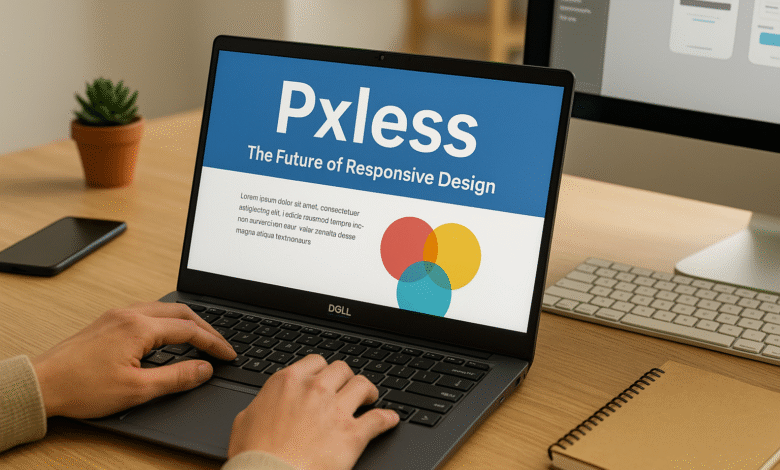Pxless: Redefining Digital Design for a Flexible and Accessible Future

Introduction
In the rapidly evolving digital world, new design philosophies continue to reshape how we build user experiences. One of the emerging ideas gaining attention is pxless. Unlike traditional methods that depend heavily on fixed pixel values, pxless promotes adaptable, scalable, and fluid systems that adjust seamlessly across various devices. This approach not only enhances usability but also ensures long-term flexibility for web design, mobile applications, and digital products.
As technology introduces a growing variety of devices—from smartphones and tablets to foldable screens, smart TVs, and wearables—the importance of pxless becomes increasingly evident. This concept is not just a trend; it is a fundamental shift toward more sustainable, inclusive, and future-ready digital design.
What Does Pxless Mean?
At its core, pxless stands for “pixel-less” or “less reliant on fixed pixels.” For decades, digital design has been centered on pixel-perfect layouts, where every element is crafted to match precise pixel dimensions. While this method once provided accuracy and control, it has become less practical in today’s multi-device environment.
Pxless challenges this rigidity by replacing absolute units with relative ones—such as percentages, rems, or viewport-based dimensions. Instead of forcing designs into static measurements, it allows elements to respond dynamically to changes in screen size, orientation, and resolution. The concept is not about eliminating pixels entirely but about reducing dependency on them to achieve fluid adaptability.
Why Pxless Matters Today
The digital landscape has never been more diverse. With billions of people accessing the internet through devices of all shapes and sizes, usability must go beyond fixed layouts. A design that appears flawless on a desktop may break or feel awkward on a smartwatch or tablet.
This is where pxless plays a critical role:
-
Consistency – It ensures that designs look professional and user-friendly on every screen.
-
Accessibility – Users who rely on larger text sizes or zoom features benefit from layouts that adjust gracefully.
-
Future-proofing – As new display technologies emerge, pxless designs remain relevant without requiring constant rework.
In short, pxless is not only about design efficiency but also about building digital products that adapt naturally to human needs.
Principles of Pxless
The pxless approach can be understood through a set of guiding principles that make it both practical and powerful:
-
Fluidity – Layouts adjust in real time based on screen size and resolution.
-
Scalability – Text, images, and content scale proportionally without losing clarity or usability.
-
Accessibility – User customization, such as resizing text or adjusting zoom levels, is fully supported.
-
Efficiency – Developers and designers spend less time fixing layouts across different devices.
-
Adaptability – Pxless designs evolve easily with new devices and display formats.
Applications of Pxless Across Industries
-
Web Design and Development
Pxless has transformed how websites are built. Instead of relying on rigid pixel-based grids, developers now use relative units like%,vh, orvwto create responsive designs. This ensures websites remain polished whether viewed on a smartphone, desktop, or ultra-wide monitor. -
Mobile Applications
With countless screen sizes in the mobile ecosystem, pxless ensures consistency. Apps designed with pxless principles adapt seamlessly, reducing fragmentation and maintaining brand identity across different platforms. -
Digital Branding and Marketing
Logos, icons, and typography must appear sharp and consistent across platforms. Pxless ensures branding elements scale smoothly, helping businesses maintain visual consistency across websites, social media, and mobile apps. -
E-commerce Platforms
Online shoppers expect effortless navigation. Pxless enhances product listings, checkout flows, and images, making sure they adapt without breaking layouts. This leads to fewer abandoned carts and higher conversions. -
Accessibility and Inclusive Design
Inclusivity is no longer optional—it’s a necessity. Pxless supports screen readers, font scaling, and other accessibility features, ensuring equal usability for people with disabilities.
Benefits of Pxless
Adopting pxless brings multiple benefits that go beyond visual appeal:
-
Responsive Experiences – Interfaces adjust fluidly for any screen size.
-
Improved Accessibility – Supports diverse user needs, from vision impairments to different device preferences.
-
Lower Maintenance – Reduces the time and cost of constant redesigns for new devices.
-
SEO Benefits – Search engines prioritize mobile-friendly, responsive designs.
-
Future-Ready – Keeps digital experiences relevant as technology advances.
Challenges of Implementing Pxless
Despite its advantages, pxless comes with challenges:
-
Learning Curve – Designers accustomed to pixel-perfect layouts must adjust to a flexible approach.
-
Tool Limitations – Many popular design tools still focus on fixed artboards, making pxless workflows less intuitive.
-
Client Expectations – Stakeholders often want static mockups, which conflict with fluid design concepts.
-
Testing Complexity – Pxless requires thorough testing across a wide variety of devices.
-
Performance Concerns – Poorly executed fluid designs can create instability or lag.
Pxless vs. Traditional Pixel-Based Design
Traditional pixel-based design offers precision and control but fails when scaled across diverse devices. Pxless, on the other hand, prioritizes adaptability, allowing for consistency in usability and accessibility. The ideal approach often blends both—maintaining design discipline while embracing responsive, flexible systems.
The Role of Pxless in Accessibility
One of the strongest arguments for pxless is its impact on accessibility. A truly inclusive design allows users to modify settings without breaking the layout. For example, enlarging text should not cause overlapping elements or broken navigation. Pxless ensures that accessibility features integrate smoothly, supporting compliance with global accessibility standards while delivering a better user experience.
The Future of Pxless
The future of pxless looks promising. As devices and display technologies continue to diversify, reliance on pixel-based layouts will fade. Design tools and frameworks are expected to evolve, providing better support for fluid and adaptable workflows. Businesses that adopt pxless early will enjoy stronger brand consistency, improved user experiences, and compliance with accessibility requirements.
FAQs About Pxless
Q1: What is pxless in simple terms?
Pxless is a design approach that reduces dependency on fixed pixel measurements and instead uses flexible, scalable units to ensure adaptability across devices.
Q2: Is pxless only for web design?
No. While it plays a major role in web design, pxless also applies to mobile apps, branding, e-commerce, and accessibility-focused digital solutions.
Q3: How does pxless improve accessibility?
Pxless allows text resizing, zooming, and customization without breaking layouts, making digital products more inclusive for users with disabilities.
Q4: Does pxless eliminate the use of pixels entirely?
Not at all. Pxless does not ignore pixels but minimizes overdependence on them to build adaptable, user-friendly systems.
Q5: What are the main challenges of using pxless?
Challenges include a steep learning curve for designers, limited support in some tools, and the need for extensive testing across multiple devices.
Conclusion
Pxless represents more than a design trend—it is a strategic response to the realities of modern digital experiences. By reducing dependence on rigid pixel-based layouts, pxless paves the way for fluid, scalable, and accessible designs that thrive across devices. Although it requires a shift in mindset and workflow, its long-term benefits make it an essential practice for businesses and designers looking to stay ahead in an increasingly diverse digital ecosystem.



